Google Nexus 4 and Nexus 10 Performance Preview
by Anand Lal Shimpi & Brian Klug on November 2, 2012 11:00 AM ESTGPU Performance
This section is particularly exciting because it's our first look at ARM's new Mali-T604 GPU in our standard mobile 3D performance suite. We've already seen the Nexus 4's Adreno 320 in action, but the Nexus 10's behavior here should be interesting to see.
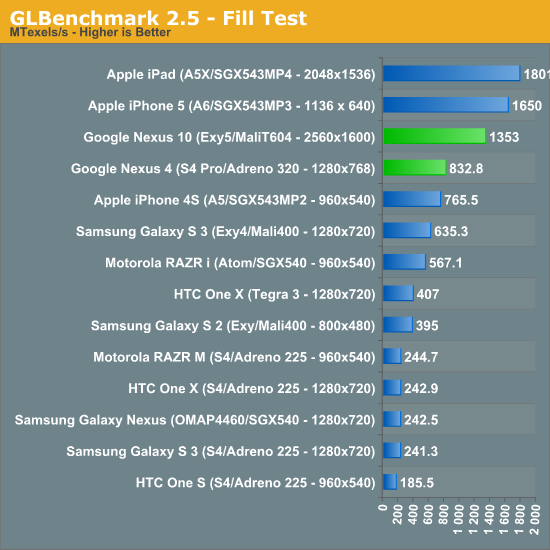
As far as raw fillrates are concerned, both Nexus devices do quite well here at their native resolutions. The iPad and iPhone 5 are both quicker, but we're still good gains over the previous generation of hardware - particularly for the Mali-T604. Compared to the Mali-400MP4 in the Galaxy S 3, we're seeing more than 2x the performance out of ARM's latest GPU.
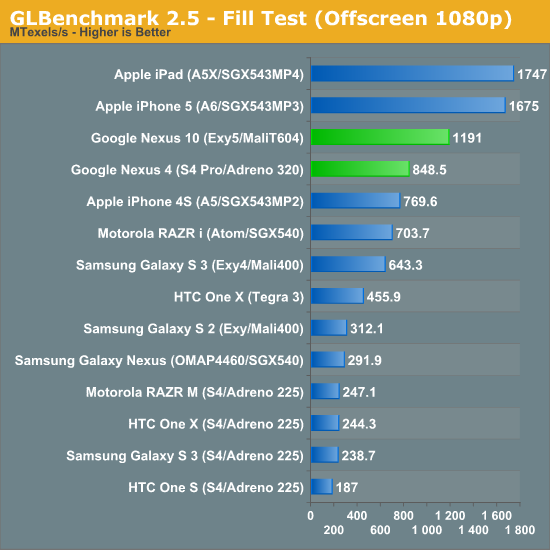
At normalized resolutions the standings don't really change.
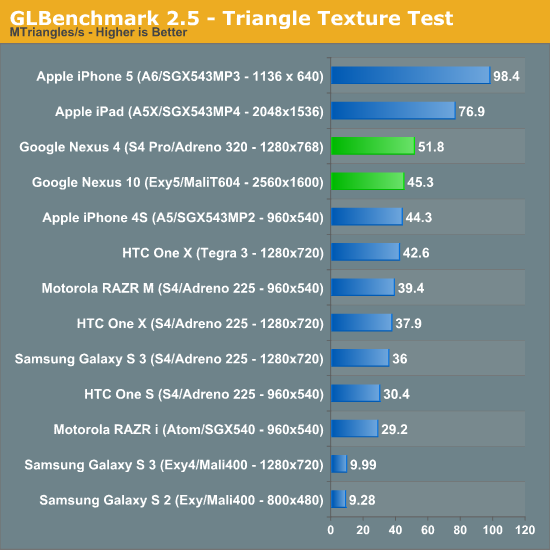
The T604 is ARM's first unified shader architecture, which gives it far more balanced pixel/vertex shader performance. The result is a more than 4x increase in triangle throughput compared to the Mali 400MP4. It's not enough to give the Nexus 10 the edge over the latest Apple devices, but it's a huge improvement over where ARM was in the previous generation. The Adreno 320 continues to be quite strong here as well.
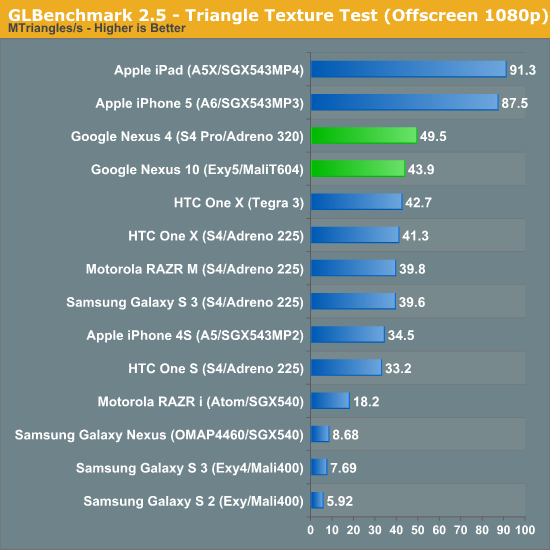
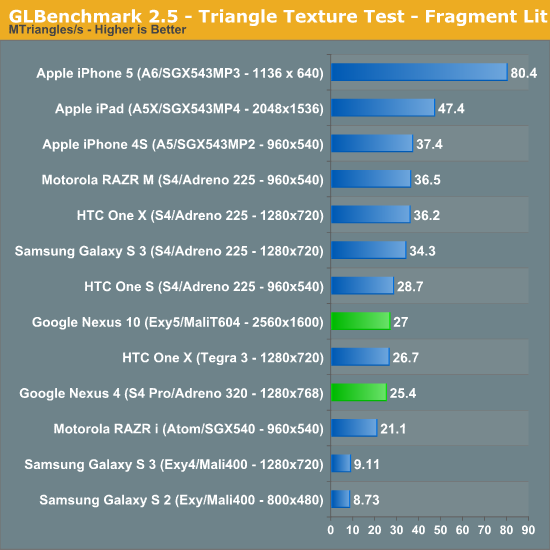
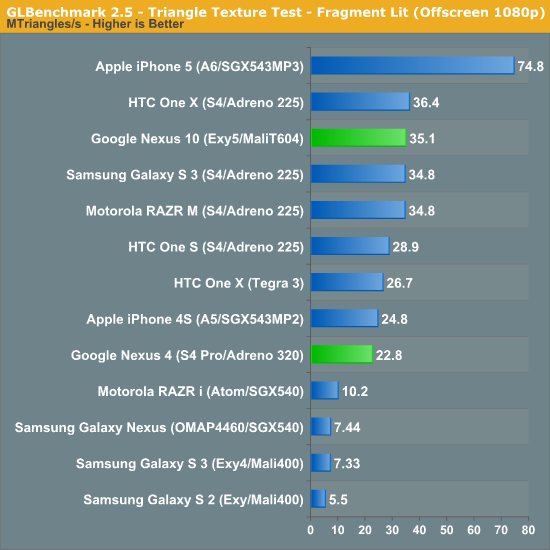
Once again we're seeing huge gains for the Mali-T604 compared to the Mali-400MP4. The Adreno 320 in the Nexus 4 actually performs worse than the Adreno 225 in older devices, possibly due to thermal throttling we saw on the Nexus 4 sample during periods of heavy load.
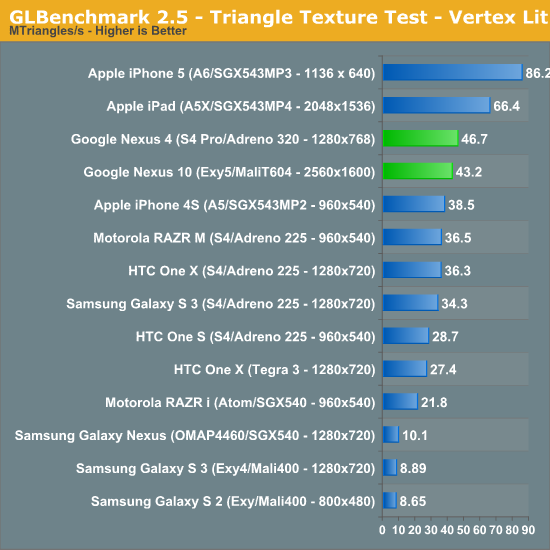
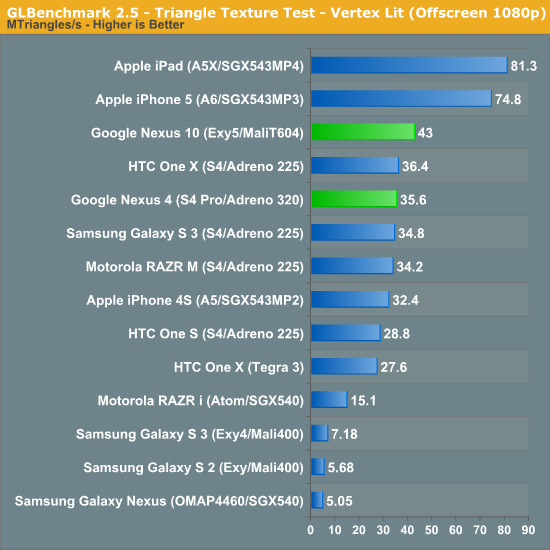
ARM shows the biggest gains here once again thanks to its move to a unified shader architecture. The Adreno 320 does ok here but it's really no better than the 225, I suspect there is some thermal throttling happening on the device.
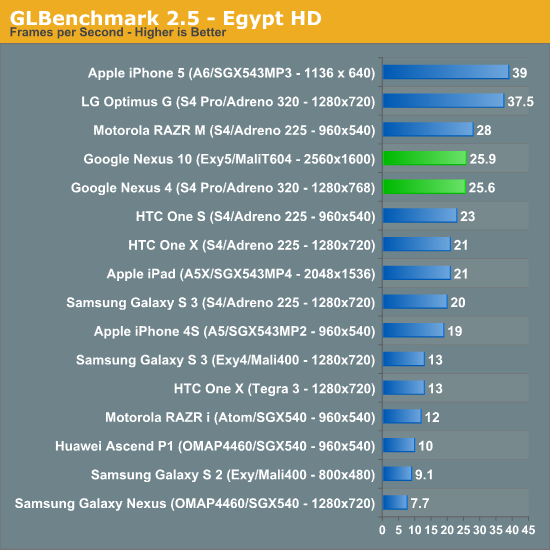
At native resolutions, the Nexus 10 and NExus 4 are both capable of putting out decent frame rates in Egypt HD. What this data tells us is they'll likely be able to run current and even some future titles, at native res, at 30 fps without much of an issue.
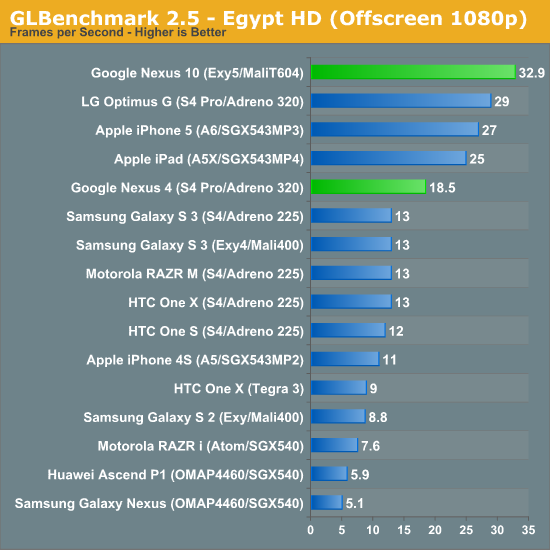
Normalize resolution and the Mali-T604 actually does very well here, setting a new performance record. Despite being based on the same hardware, the Optimus G is able to post a much higher score here than the Nexus 4. The explanation is simple: the Optimus G can't complete a single, continuous run of GLBenchmark 2.5 - the app will run out of texture memory and crash if you try to run through the entire suite in a single setting. The outcome is that the Optimus G avoids some otherwise nasty throttling. The Nexus 4 on the other hand manages to complete everything, but likely quickly throttles its clocks down due to thermal constraints. The Nexus 4 was really hot by the end of our GLBenchmark run, which does point to some thermal throttling going on here. I do wonder if the Snapdragon S4 Pro is a bit too much for a smartphone, and is better suited for a tablet at 28nm.
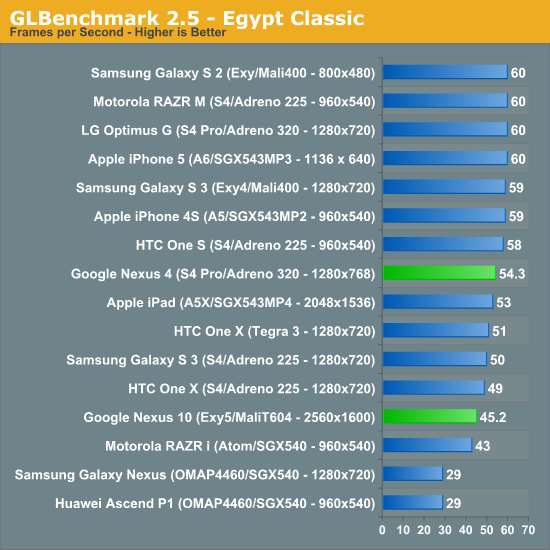
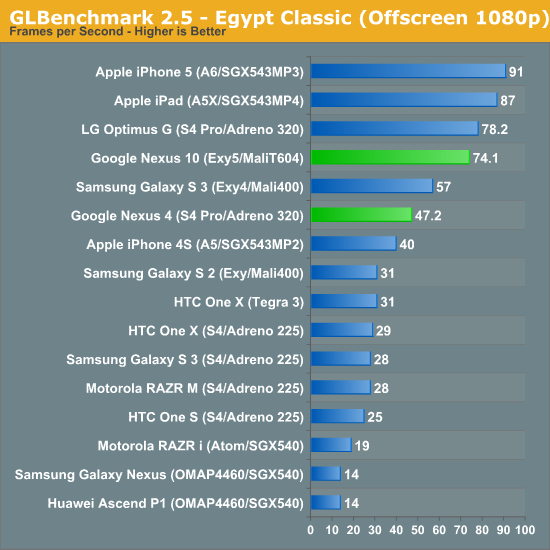
The Egypt Classic numbers are less interesting, but both platforms do well here.
Battery Life
We didn't have time to run through our entire battery life suite, but we do have some relevant results for the two devices. For smartphones, these are our latest web browsing battery life tests:
We regularly load web pages at a fixed interval until the battery dies (all displays are calibrated to 200 nits as always). The differences between this test and our previous one boil down to the amount of network activity and CPU load.
On the network side, we've done a lot more to prevent aggressive browser caching of our web pages. Some caching is important otherwise you end up with a baseband test, but it's clear what we had previously wasn't working. Brian made sure that despite the increased network load, the baseband still had the opportunity to enter its idle state during the course of the benchmark.
We also increased CPU workload along two vectors: we decreased pause time between web page loads and we shifted to full desktop web pages, some of which are very js heavy. The end result is a CPU usage profile that mimics constant, heavy usage beyond just web browsing. Everything you do on your smartphone ends up causing CPU usage peaks - opening applications, navigating around the OS and of course using apps themselves. Our 5th generation web browsing battery life test should map well to more types of smartphone usage, not just idle content consumption of data from web pages.
As always we test across multiple air interfaces (3G, 4G LTE, WiFi), but due to the increased network load we actually find that on a given process technology we see an increase in battery life on faster network connections. The why is quite simple to understand: the faster a page is able to fully render, the quicker all components can drive down to their idle power states.
All Android tests use Chrome and 5GHz WiFi unless otherwise listed.
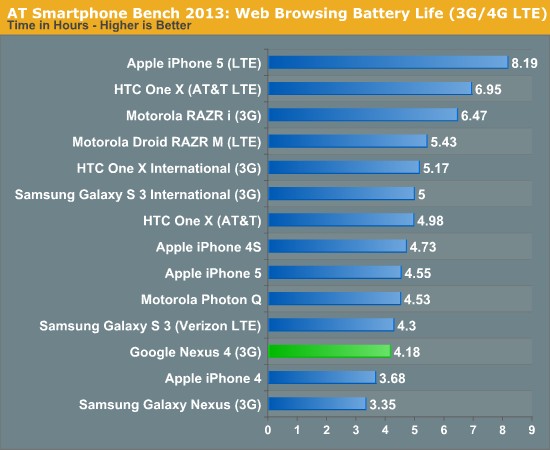
The Nexus 4 doesn't break any records for 3G battery life, it ends up relatively low on our list - even the Galaxy S 3 manages to do better here on 3G.

WiFi battery life is similar to the Galaxy S 3, but again it's not all that impressive compared to some of the other devices in this list.
Our tablet web browsing battery life test isn't directly comparable to the new smartphone tests, so we've got a separate chart for the Nexus 10:
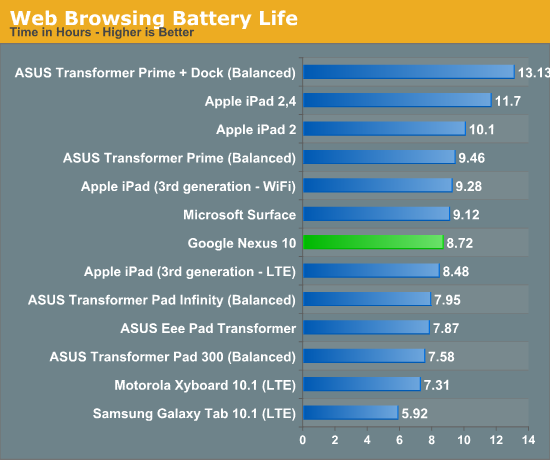
Despite driving a very high res panel, Google is able to deliver relatively competitive battery life with the Nexus 10. Battery capacity is around 80% the size of the 3rd gen iPad and battery life is around 93% of what Apple delivers here. Over 10 hours would be nice to have, but 8 hours of use in this test isn't bad at all. We'll have to do more testing to understand Exynos 5's power behavior a bit better, but so far it doesn't seem that the platform is all that bad from a power consumption standpoint. It remains to be seen how gracefully the Nexus 10 will handle being taxed heavier.
Display
We're still running our big display analysis routines on the new Nexus devices, but the brightness/contrast data below is a little teaser:
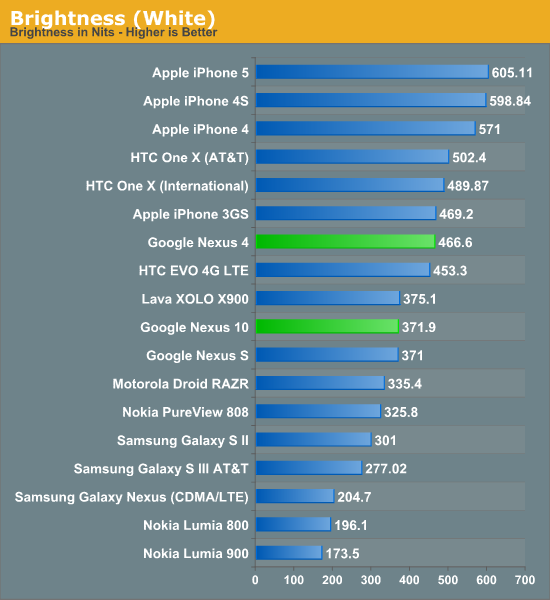
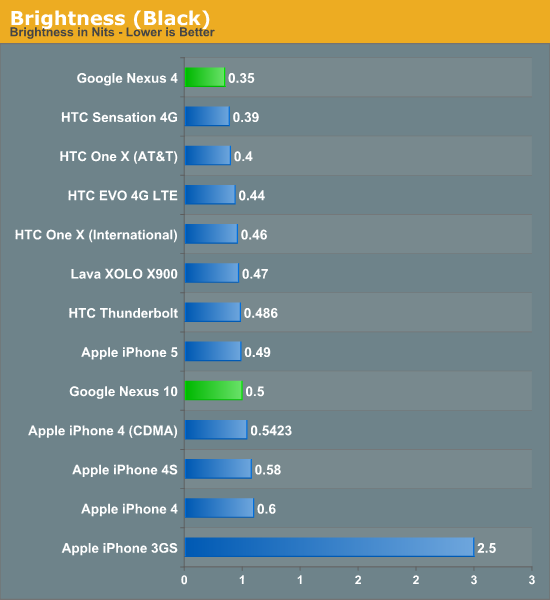
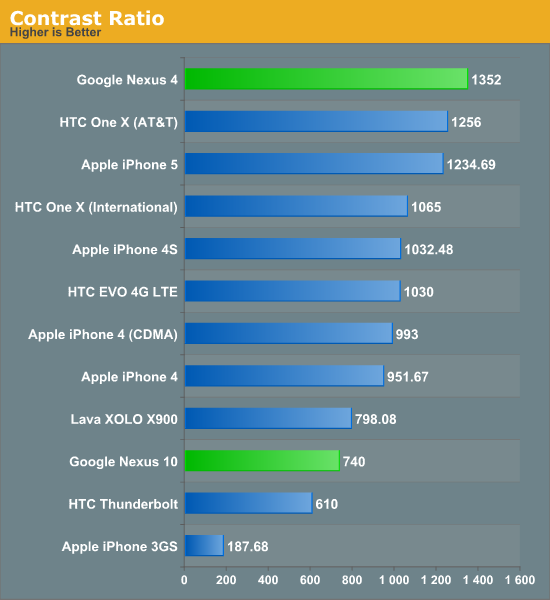
Final Words
We still have a lot of additional writing and testing ahead of us. Stay tuned for our full review of both devices!










244 Comments
View All Comments
nmPraveen - Friday, November 2, 2012 - link
Add iPad4 benchmark values too.PeteH - Friday, November 2, 2012 - link
iPad4 just came out today, so it hasn't been benchmarked yet.doobydoo - Saturday, November 3, 2012 - link
When did the Nexus 10 come out?firesyde424 - Friday, November 2, 2012 - link
I get the general idea that, for whatever reason, it's fairly difficult to get anything more than a ballpark idea about relative speed when comparing smartphones. For instance, most of AT's benchmarks show the US version of the HTC One X as faster than the international version. Having had both of them sitting next to each other, my benchmarks don't bear that out. My benchmarks show the Internation version as considerably faster in cpu tests and in gpu tests, the two were roughly even.Even in this article, my Octane score for the Int S3 and Int HOX were 3-400 points higher than AT has listed here. I'm not saying that AT's scores are invalid. My gripe is that there doesn't seem to be a lot of consistency in the mobile computing space yet. Hopefully that changes with further generations of smartphones.
nidz1 - Friday, November 2, 2012 - link
I'll take these benchmarks with a grain of salt. My Galaxy Nexus on 4.1.2, running the stock kernel, with no overclocking, receives a 1601ms in Chrome, and 1420ms in the AOSP browser. I receive a 113031 on Chrome in browsermark, and a 133981 with the AOSP browser.I'm indifferent in regards to the GPU benchmarks, because I'm able to play all current games on my Gnex with no noticeable lag. Once the software issues with the Nexus 4 are sorted out, I'm sure it will be noticeably better than my Galaxy Nexus. I'll still probably pick up a Nexus 4, if I like the screen, because one year of service with T-Mobile & a Nexus 4 only costs $660, which is the price of a SGS3, One X+, or iPhone 5.
Aenean144 - Friday, November 2, 2012 - link
Have some perspective guys. For all intents and purposes, you can mix and match most of these ARM smartphones and tablets as they use the same platform. In most of these cases, it's basically the same SoC.For GPU benchmarks, you must always keep the native resolution in mind when interpreting scores.
For CPU javascript benchmarks, it's basically the best we got to compare across platforms. It's highly sensitive to the browser and its JIT compiler, so it's typically best to compare across the same platform and browser version for those. They'll do linpack and others eventually, but that'll take time. If SpecINT and SpecFP could be ported, I'm sure they'll use those.
Ideally, Anandtech could write its own benchmark code and compile them for each platform, but that'll take time and effort they likely don't have. I'm sure they won't mind if someone else develops the code.
MadMan007 - Saturday, November 3, 2012 - link
AT is not some rinky dink website run out of someone's paretn's basement. Have you seen Anand's home theater and house? He makes enough money from AT to pay for a dev if he wants to.Aenean144 - Tuesday, November 6, 2012 - link
Anandtech is like 3 or 4 guys, and they do lots of reviews on other hardware. The work to do this is not trivial, the benchmark software is not consistent across platforms and sometimes not consistent within platform versions. Every time a new benchmark is developed, a lot of devices have to be rerun. It's a rather difficult problem to continuously rerun benchmarks and make sure everything is consistent. It isn't going to happen fast, and there won't be a broad swath of hardware they'll have benchmarks on.Take the benchmarks for what they are worth. They are there to characterize the performance of the platform. If you want to compare who's the winner between platform A versus platform B, the tools really aren't there to precisely do that.
Impulses - Friday, November 2, 2012 - link
Looks like the S4 Pro was shoehorned pretty hard into a phone, kinda ironic considering the last two Nexus phones didn't really feature a SoC that was any better than what was on the market already (and people criticized them for it, now it may be the other way around). Shouldn't Qualcomm have a dual core Krait w/the new Adreno coming out towards year's end/next year?Mumrik - Friday, November 2, 2012 - link
I simply don't get it. Do people really care if their phone is 9mm thick or 1.1cm?Give me a bit more thickness and a much larger battery. Motorola has it right with those MAXX phones and they aren't thick.